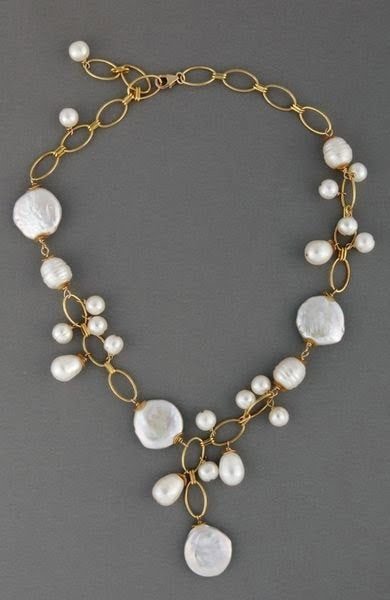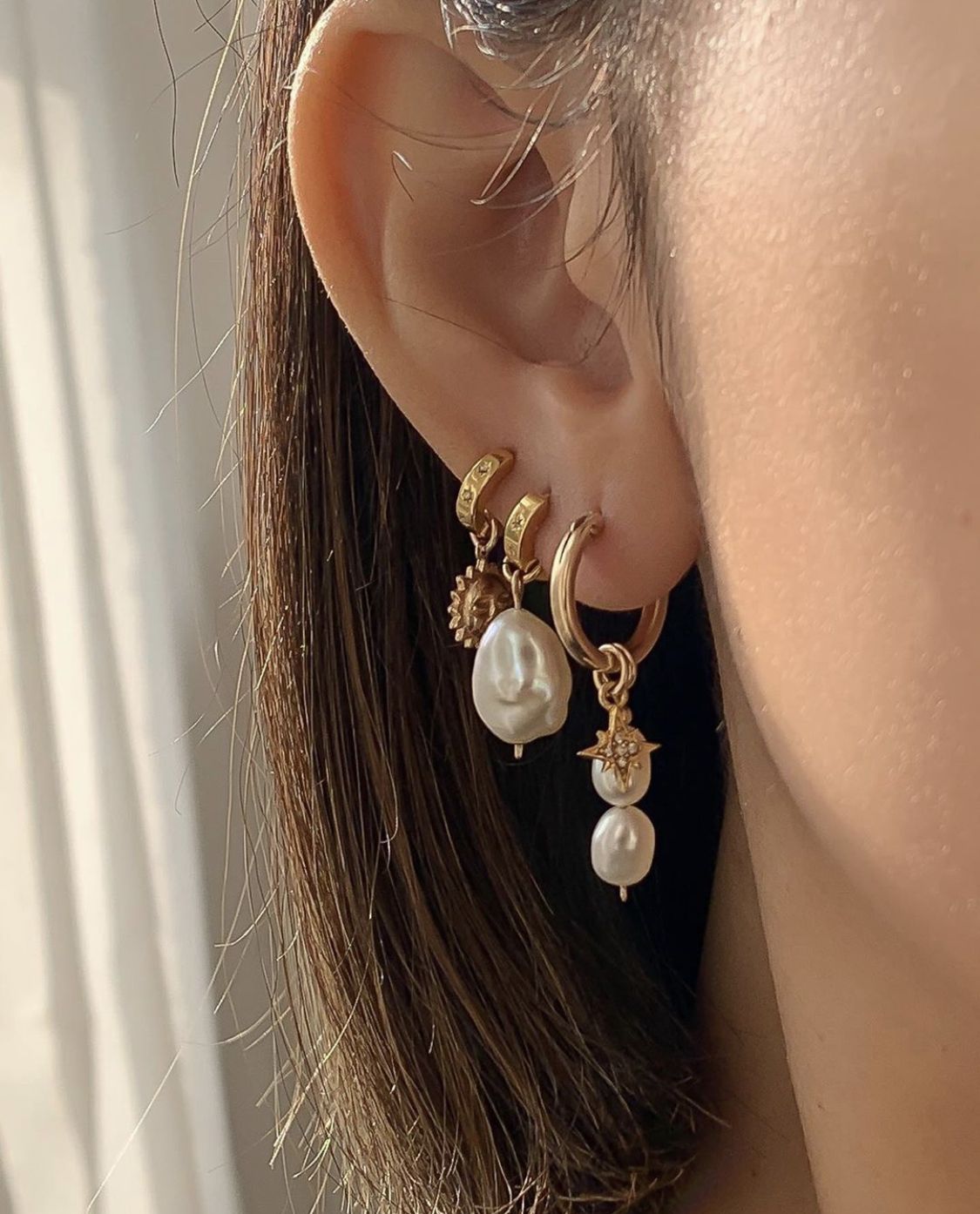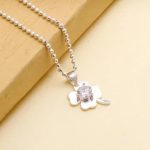The 1930s were a period of transformation for the jewelry industry, due in part to the art deco movement. The art deco trend emerged during this decade and it was renowned for its modern, luxury look that showcased geometric and architectural shapes. Art deco jewelry also incorporated bold colors and precious metals to create statement pieces that were often adorned with gemstones and diamonds.
These pieces offered a stunning contrast to Victorian-style designs, which had been popular for many years prior. There was an appetite from consumers for something modern, different yet still luxurious and beautiful – all combined together gave birth to 1930s Art Deco Jewelry.
Designs of 1930s Art Deco Jewelry The use of materials in art deco jewelry was eclectic and diverse; ranging from gold-plated metal and geometric shapes such as diamonds cut into rectangles or octagons, to stones such as emeralds, turquoise or onyx used as centerpiece gems in necklaces or pinned brooches.
Popular motifs included chevrons, sunbursts, Greek keys and “X” signs among other abstract shapes which all contributed to creating beautiful jewelry pieces admired by many collectors around the world even today.
Impact of 1930s Art Deco Jewelry The impact that Art Deco had on jewelry design was huge with creative new ideas unleashed bringing much enthusiasm within the world of fashion circles mingled with socialites who wore these pieces with pride at various public events during the late 30´s period.
For some designer brands their brand took a large leap forward establishing them at the forefront of customer´s attention when seeking good quality fashionable styles that could be appreciated by viewers who wanted something out of the ordinary but still sophisticated within cost limits set by themselves or family members supporting their purchases.
Origins, Influences & Characteristics of Art Deco Jewelry
The origins of 1930s Art Deco jewelry began in the French Art Movement of 1925, where Parisian designers sought to combine a modernist form with a classical structure. This was an aesthetic which conveyed sophistication and refinement, in line with the Fashion Revolution of the time.
Popular motifs featured nature such as animals and flowers as well as geometric shapes like chevrons, zig-zags and fans. Other influences of the period included Ancient Egypt, Aztec and Mayan cultures, which were often depicted stylistically on these precious pieces.
Most pieces of 1930s Art Deco jewelry had white gold or platinum settings with diamonds taking center stage. However, it wasn’t just diamond but everything from rubies to bright tourmaline and aquamarine stones that added vibrant colors to these stunning artifacts. Silver was also popular when it came to accessories from this decade – pendants with string chains or bangles adorned with bezel set gemstones were very much in trend.
Apart from diamond solitaires a variation of designs gave birth to several imaginative jewelry forms: two toned necklaces featuring rhodochrosite cabochons along with diamond set entourage; bold cocktail rings boasting richly colored sapphires; light-weight diamond bracelets embedded in yellow gold featuring abstract flower patterns; double finger rings donnedby fashionable ladies making statements alike – a true testimony to some craftsmanship unparalleled since then.
This new style not only sought to break away from previous craftsmanship but used cutting edge design techniques like filigree and vignette that carried into even more modern day pieces.
Popular Jewelry Materials Used in Art Deco Jewelry Design
The most popular materials used in Art Deco jewelry design were gold, platinum, and precious stones. Platinum and gold were the main metals used for various types of pieces including pendants, necklaces, rings and bracelets. These materials provided an elegant foundation for the intricate designs found in Art Deco jewelry.
Precious stones were also often used to add a splash of color and sparkle to the pieces and could be cut into almost any shape or size desired by the designer. Aquamarine, Ruby, Onyx, and Diamonds were among some of the more popular gems used during this time period.
Symbolism Used In Jewelry Design
Art Deco jewelry was known for its use of symbolism. The pieces often featured bold geometric patterns that represented new elements being added to traditional designs like sunbursts or zigzags. Other popular symbols included mythical creatures such as dragons, as well as faces of royalty or gods from ancient civilizations.
Additionally many designs incorporated Egyptian motifs in their designs such as pharaoh masks or hieroglyphics. Not only did these symbols add mystery to the piece but also packed it with meaning that individual wearers could appreciate on a personal level.
The Changing Nature Of Popularity
The popularity of Art Deco jewelry wasn’t consistent throughout its reign millennia due to political changes in countries around the world during this time period that impacted fashion trends greatly. In France it enjoyed great popularity whereas not so much in England or America.
Nonetheless this exquisite style still managed to make it’s way across ocean borders albeit slightly muted in comparison to its full force presence on other continents. A testament to its rise in notoriety was when top jewellers Cartier created iconic pieces within their private collections that showcased Art Deco trends for all of Europe to admire and replicate accordingly.
Availability of Art Deco Jewelry During the 1930s
The 1930s saw the production of many stylish pieces in Art Deco style. Although it was particularly popular during this decade, it’s important to note that even before the start of the 1930s, Art Deco was widely used by jewelers all over the world.
One of its main attractions is that it could be made using a variety of materials, meaning that whether you were looking for something understated or elaborately embellished, there was an option out there for you.
Types of Materials Used For Art Deco Jewelry
Common materials used to create jewelry in this era include platinum, gold, and silver; as well as a range of gemstones such as diamond, sapphire and emeralds. Additionally, some pieces included semi-precious stones such as tourmaline and coral.
Many jewels were also set with pave or channel-set diamonds. This technique refers to when jewels are cut into shapes and sizes and set very closely together in order to add a unique texture and texture pattern to the final design.
Art Deco Design Elements Popular During The 1930s
During this period there were plenty stylish designs being produced by top designers around the world. Some hallmarks of an Art Deco piece from the 1930s includes Use strong geometric shapes like triangles, squares and rectangles in either contrastings or complementary colors. Cubic Zirconia (CZ) was a popular stone used due its resemblance to diamonds at a fraction of the price.
Additionally, influences from cultures like Egyptian, Aztec & Mayan can sometimes be seen within an Art Deco piece. Here is a list of design elements common found in jewellery from this era:
- Geometric Shapes
- Cubic Zirconia
- Bright Colours
- Pyramids
- Step Cuts
- Fancier Clasps
Understanding the Popularity of Art Deco Jewelry in the 1930s
The influence of Art Deco on jewelry production and design flourished in the 1930s with the most popular pieces featuring sleek geometric shapes and exotic designs. This was largely influenced by the new lifestyle associated with glamour and luxury that had become popular due to the movie stars, mobsters, businessmen, and socialites that belonged to the this time period. Here are a few elements that made Art Deco jewelry so popular in the 1930s:
Incorporation of Precious Stones & Metals
Many Art Deco jewelry pieces created during this era featured precious stones such as diamonds, rubies, emeralds, sapphires and precious metals such as gold, platinum or silver. This made these pieces high in quality and value as well as attractive to affluent customers looking for luxurious jewellery for special occasions.
Multi-Faceted Construction
Unlike other jewellery designs of its time which featured dainty construction techniques, artists crafted oblique angles and multiple facets into every piece to make it unique. This distinctive style was often combined with bright enamel colours and ethnic motifs to create interesting statement jewellery that was one of a kind compared to other pieces at the time.
Influences from Cubism & Surrealism
Artists were heavily influenced by European art styles like Cubism which blurred lines between realistic art depictions and abstract interpretations while Surrealism brought forth images found in dreams yet still documented reality through different symbolic expressions. Both of these techniques gave Art Deco jewellery an unconventional beauty which appealed greatly throughout the 1930s making them highly sought after pieces.
- The incorporation of precious stones & metals.
- Multi-faceted construction.
- Influences from Cubism & Surrealism.
Notable Art Deco Jewelry Designers of the 1930s
In the 1930s, Art Deco jewelry set the standard for luxury adornment. Designers such as Jean Desprès and Georges Fouquet were influential in this design movement. Desprès’ influence on the 1930’s art deco style included his use of vibrant stones such as emeralds and rubies to craft eye-catching pieces.
His works often used glossy materials like jade, coral, tortoiseshell, and ivory to produce unforgettable jewelry. Georges Fouquet also brought a fresh approach to 1930’s art deco jewelry by crafting streamlined pieces that combined precious metals with semi-precious gems such as lapis lazuli and turquoise.
Louis Cartier
Louis Cartier was another prominent designer from the era who is fondly remembered for his stunning sapphire and diamond pieces that blended geometric shapes beautifully. This hugely popular brand still uses the same techniques and inspiration in production today.
However, it was in the 1930s when they began to attract attention for their modern approach to art deco style jewelry incorporating bright colors alongside motionless shapes like circles and squares. Among some of their most famous pieces from the period are their mens’ watches that combined traditional craftsmanship with contemporary design ideas.
Rene Boivin
Another notable artisan during this period was Rene Boivin who incorporated urban elements into his designs creating striking necklaces using glass beads, leather fabric beads, geometric shapes set in platinum or gold or studded with diamonds. In addition to these unique items of beauty, he also crafted exquisite rings made from various materials including sapphires, quartz, emeralds, tourmalines and rubies all arranged in geometric patterns which quickly became a favorite among Hollywood celebrities at the time.
The designer left an indelible mark during this era where timeless classics were being created using innovative approaches towards traditional styles.
These Designs Stayed Superior Through Multiple Decades
In spite of its brief emergence during this era, Art Deco has remained incredibly popular even unto modern times due to its timeless quality which allows us to effortlessly integrate past styles into our current day looks while still retaining a classic feel suitable for many occasions both formal and informal alike.
As this innovation continues we can look forward to more creative use of bold lines mixed with intricate details within an assortment of gemstone combinations throughout multiple decades yet to come giving us unparalleled access to these classic designs at all times.
Best-selling Art Deco Jewelry Designs of the 1930s
The 1930s was a prosperous period for the development of Art Deco Jewelry both in terms of fame and popularity. During this decade, it was considered a trend to possess as well as wear jewelry stylishly with all the outfits. This sparked an immense interest among people from all classes including wealthy individuals who desired to purchase high-end designs produced by noteworthy jewelers.
The most iconic jewelers of the day, such as Van Cleef & Arpels, Cartier, Bulgari and Mauboussin explored innovative combinations of materials and techniques like marquetry, enameling and rare gemstones to create timeless pieces of jewelry. It became quite common for intricate pieces to be extremely heavy and adorned with large gemstones such as diamonds and rubies.
Noteworthy trends during this era include pave diamonds set into two-tone metal bands, asymmektrocy designs taking inspiration from nature such as plants and animals which had geometric forms incorporated in them. Furthermore necklaces often were complemented by spikey bold earrings that generated contrast within the outfit itself.
A number of classic Art Deco Jewelry still remains popular even today; some of these that flourished during the 1930s are still highly sought after by collectors around the world. These timeless designs remain relevant due to their aesthetic sophistication even after more than 80 years have passed since they were unique introduced in the market.
Pieces incorporating vibrant colors like pink sapphires or blue turquoise stored its position over time, while silver accessories became wildly popular due to their luxury feel at affordable costs. In summary, Art Deco jewelry flooded during this decade.
Controversial Art Deco Jewelry Designs of the 1930s
The 1930s marked an era of innovative, yet controversial designs in jewelry. This period was characterized by the Art Deco movement and its abstract geometric shapes, heavy embellishment, and impressive stones of vivid colors. These pieces served to make a statement in both their complex expressiveness and luxurious materials.
The decadence of Art Deco jewelry was epitomized by creations from top jewelry designers such as Fulco di Verdura, Cartier, Van Cleef & Arpels, and Chanel. They represented the wealth and status of the buyers without fail. Houses clad with this jewelry were sure to feature eye-catching necklaces that branched off to earrings featuring bold cuts like baguette diamonds.
Despite being part of a successful era for jewelry makers during the 1930s, many Art Deco designs were met with disapproval in some circles. This was because they condoned a ‘departed luxury’ that ran counter to contemporary ideals set forth by the Great Depression era. In addition, prominent members of society found them ‘new-fangled’ or demonstrative instead preferring more classic silhouettes.
Despite this controversy, not all pieces were deemed too bold or avant-garde; some could barely pass as understated elegance in comparison to other extravagant accessory designs created. To demonstrate these intricate yet subtle styles, here are 3 common types from the 1930s:
- Suite Sets: These featured compact pieces with a coordinated necklace dangling below a desirable brooch
- Vanity Bags: Stylish makeup bags covered with gems; usually decorated with combs encrusted in jewels too
- Sprague Jewelry Watches: Elegant watches embossed on one side with embossing shaped like flowers
Conclusion
The 1930s saw a great surge in the popularity of art deco jewelry designs. The demand for this distinct style was much higher than it had been in previous eras, and the pieces from the ’30s are now collectible antiques. They come with unique stories, many having once belonged to famous people or being used as tokens of special relationships.
This form of jewelry is an absolute favorite among vintage collectors as well as costume jewelry enthusiasts. Its geometric shapes, bold lines, and eye-catching colors make them stand out even today, and their timeless beauty ensures that it will continue to be relevant long into the future.
Not only was art deco jewelry popular in the 1930s but it was also seen as a modern statement of fashion. It was designed to fit with the sleek clothing silhouettes of that era while also creating a dramatic aesthetic effect.
Art deco designs were far from traditional – they featured carvings, gemstones, enameling and often colorful glass stones – such features allowed wearers to make individual statements about themselves through their choice in accessories.
This rebellious expression is part of what makes these specialty pieces so appealing today; there is something quite exciting about wearing retro fashion statement pieces that herald from a very different time period yet have maintained their aesthetic appeal throughout the decades Many art deco items feature elaborate engraving styles or interesting shapes like circles and barrels which add to their enduring appeal over time.
Further backing its timelessness is the wide variety of materials used across both precious metals such as platinum, yellow gold or silver alongside base metals like copper or bronze alloys for less expensive productions at that time.
In terms of quality craftsmanship, modern artisans now have access to improved technology such as better machines and machinery which means that equally remarkable metalworks can be created using modern production techniques without sacrificing on quality unlike almost a century ago when hand crafting delicate pieces would take months or years due to laborious processes with basic tools available at the time.
Art Deco Jewelry from the 1930’s quickly gained popularity amongst society for new reasons even when faced with competition from modern styles making them evermore treasured items found around the world by those who aren’t willing to part ways with history’s past findings.

Welcome to my jewelry blog! My name is Sarah and I am the owner of this blog.
I love making jewelry and sharing my creations with others.
So whether you’re someone who loves wearing jewelry yourself or simply enjoys learning about it, be sure to check out my blog for insightful posts on everything related to this exciting topic!





